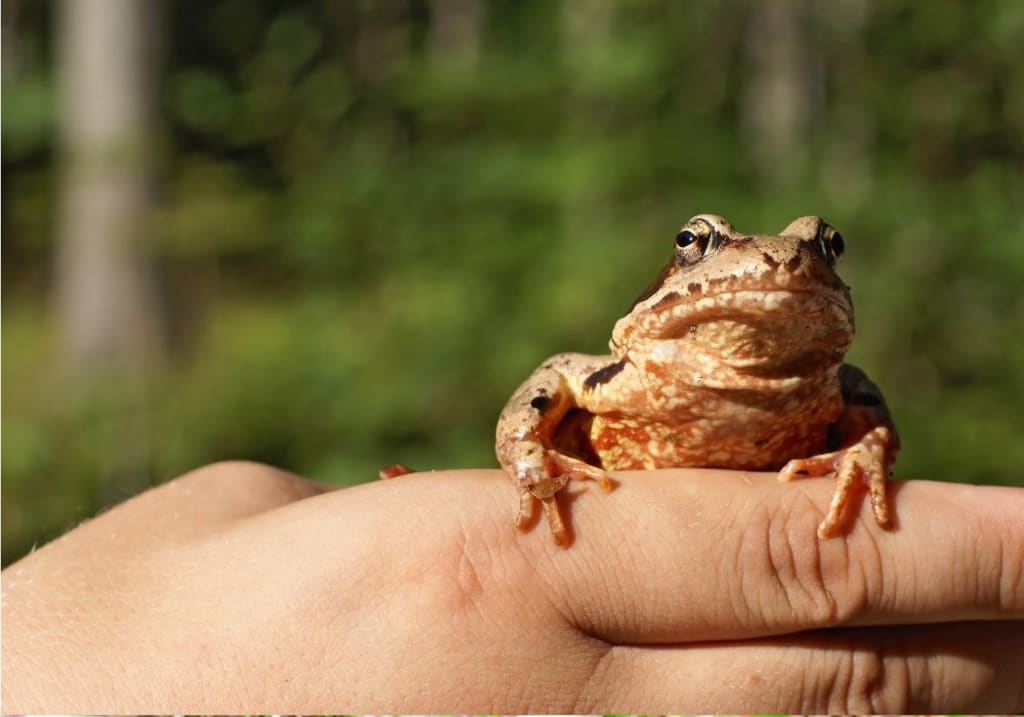Recognizing and Treating Common Illnesses
Keep Your Frog Healthy

Introduction to Common Diseases in Pet Frogs
Owning a pet frog comes with the responsibility of ensuring they stay healthy and happy. Common diseases in pet frogs can be difficult to diagnose and treat, but recognizing the signs of illness in your frog early can help you give them the best chance of a full recovery. This article will provide an introduction to common diseases in pet frogs, including symptoms and treatments.
Bacterial Infections
Bacterial infections are one of the most common health issues experienced by pet frogs. Symptoms can include skin lesions, loss of appetite, lethargy, and swollen joints. The bacteria responsible for these infections are often found in ponds or other wet environments where frogs live. If a bacterial infection is suspected, a sample should be taken from the frog's skin or mouth and tested for bacteria before starting any treatment. Treatment typically includes antibiotics administered either orally or by injection, as well as supportive care such as providing warmth and fluids.
Parasitic Infections
Parasites such as worms, flukes, and mites can cause disease in pet frogs. Symptoms range from mild to severe, depending on the type of parasite present. Common signs include discoloration of the skin or eyes, weight loss, and difficulty breathing. Diagnosis is usually done through examination under a microscope or with laboratory tests like PCR testing to identify parasites present in the tissue samples taken from the frog's body. Treatment often involves medication to kill off parasites or medication to enhance immunity against them as well as supportive care such as providing warmth and fluids for recovery.
Fungal Infections
Fungal infections are another common health issue seen in pet frogs. Signs of a fungal infection include white patches on the skin that may have gray edges or silvery scales at their base; yellowish-green patches on the skin; red streaks on legs; swollen toes; or white spots near eyes or gills. Treatment usually requires antifungal medications administered orally or by injection, as well as supporting care such as keeping them warm and hydrated while they recover from illness.
Respiratory Problems
Respiratory problems can be caused by cold temperatures, improper housing conditions (such as inadequate ventilation), poor water quality, inadequate nutrition, stress due to environmental changes (such as transport), exposure to chemicals like chlorine or ammonia that irritate respiratory systems, bacterial infections, fungal infections, parasitic infestations (such as flukes), trauma due to fighting with other animals in their environment etcetera .
Symptoms may include wheezing sounds when breathing along with lethargy and general unresponsiveness from your frog pal . Diagnosis is done usually through physical examination along with other tests if needed like laboratory tests which might involve chest X-rays etcetera . Depending on what’s causing it , treatment may involve antibiotics , oxygen therapy , antifungals , prescription anti-parasite medications , antiprotozoan medications etcetera . Supportive care such as providing warmth and fluids is also necessary for recovery .
Conclusion
Common diseases in pet frogs range from bacterial infections to respiratory problems caused by improper housing conditions and exposure to chemicals that irritate respiratory systems . Recognizing signs of illness early can help you give your frog pal the best chance for recovery . It’s important you seek professional veterinary advice if your frog displays any unexplained symptoms so that diagnosis is done accurately followed by appropriate treatment given . If you take proper care then keeping your frog healthy should not be too difficult !
Signs and Symptoms of Diseases in Pet Frogs
As a pet frog owner, it is important to be aware of the common diseases that can affect your amphibian. Common diseases in pet frogs can range from minor skin conditions to life-threatening illnesses. Knowing the signs and symptoms of disease can help you quickly identify an issue with your frog and seek appropriate treatment. One of the most common diseases in pet frogs is red leg, which is caused by a bacteria. You may notice that your frog's legs become swollen or show signs of redness, which may also be accompanied by labored breathing or lethargy. If left untreated, this condition can be fatal for your frog.
Another common illness is mouth rot, which is caused by bacteria or fungus and can be identified by white lesions around the mouth area of your frog. The best ways to prevent against these common ailments are keeping the aquarium clean and providing them with a balanced diet and adequate ventilation. In addition to bacterial infections, parasites are also something you should pay attention to with pet frogs. Many parasitic infections are visible on the skin or in the feces of your frog, so it's important to regularly check for signs of parasites as part of your routine health care regimen. Common parasites found in frogs include nematodes, flukes, tapeworms and more – all of which require treatment from a veterinarian if found early enough.
Fungal infections are another type of disease that you may encounter when caring for pet frogs. Fungal infections usually start as small white spots on the skin that have fuzzy edges. If left untreated, these spots can spread rapidly across the body which could lead to death if not treated swiftly by a veterinarian. Finally, respiratory issues such as pneumonia should also be monitored in pet frogs. Signs that indicate respiratory issues include wheezing sounds when breathing, sluggishness or loss of appetite – all signs which suggest it’s time for a trip to the vet!
When it comes to recognizing and treating common illnesses in pet frogs, knowing what to look out for can help you identify potential issues before they get out of hand! Make sure that you regularly check their environment for cleanliness, monitor their diet for balance and keep an eye out for any physical changes or strange behavior – all these things will help you stay on top any potential health problems.
Prevention Strategies for Keeping Your Frog Healthy
Good healthcare and maintenance are essential to keeping your pet frog healthy. Common diseases in pet frogs can be prevented and treated. It is important to understand the signs and symptoms of certain illnesses, so you can take action if your frog exhibits any changes in its behavior or physical appearance. Here are some prevention strategies for keeping your frog healthy.
Maintaining Proper Nutrition
One way to ensure a healthy pet frog is to provide them with a balanced diet that meets their nutritional needs. This includes feeding them a variety of foods such as live insects, freeze-dried food, worms, and vegetables. Additionally, always provide fresh water daily and keep the enclosure clean by replacing the substrate (such as peat moss) regularly. Proper nutrition is key for maintaining a healthy immune system and preventing common diseases in pet frogs from developing.
Protecting Against Parasites
Parasitic infections are one of the most common illnesses seen in pet frogs. To prevent parasites from entering your frog's enclosure, it is important to quarantine any new frogs before introducing them into their environment. If you plan on adding live plants or fish into your frog’s habitat, make sure they have been treated with chemicals like Formalin or Malachite Green first. Additionally, dipping all new items into bleach water before placing them in the tank will help reduce the risk of infection even further.
Providing Optimal Temperature & Humidity
Frogs are sensitive to temperature changes so it’s important to monitor air temperature within their enclosure often. A thermometer should be used to determine optimal temperatures for different species of frogs and they may need supplemental heating if temperatures drop too low during winter months or other times of lower ambient room temperature in your house or apartment living space where they may reside.. In addition to providing optimal temperature levels within the enclosure, it is also important to maintain proper humidity levels as this can prevent common diseases in pet frogs due to excessive dryness or moisture build-up within their environment.
Having a clean and comfortable environment is an essential element when caring for any pet frog. By following these simple prevention strategies you can give your beloved amphibian companion long-term health benefits that will help them stay happy and active throughout their lifetime!
Diagnosing and Treating Common Illnesses in Pet Frogs
When it comes to pet frogs, one of the most important things a pet owner can do is recognize and treat common illnesses. Common diseases in pet frogs can range from simple skin infections to more complex illnesses such as mycobacteriosis or ranavirus. Knowing the signs of these diseases and taking proper preventive measures can help ensure your pet frog's health and wellbeing.
One of the first steps to keeping your frog healthy is to be aware of any physical changes to its body. If your frog appears lethargic, has unusual spots on its skin, is losing weight, or has any other changes in its appearance or behavior, you should take it to a vet as soon as possible for an exam. It's also important to keep an eye out for any unusual bumps, lumps or discoloration on your frog's skin.
If you suspect that your frog may have contracted a disease, there are certain tests that your vet will run in order to make a diagnosis. These tests can include blood work, fecal tests and X-rays. Depending on the results of these tests, your vet may prescribe medication or recommend surgery if necessary.
Once a diagnosis has been made, it's important that you follow all directions given by the veterinarian for treatment of the disease. This may include giving oral medications or topical treatments on a regular basis. In some cases, providing extra vitamins and nutrition supplements may also be necessary to help strengthen your frog’s immune system against further infections.
It is also important that you take steps at home to prevent common illnesses from occurring in the first place. This includes cleaning and disinfecting tanks regularly, monitoring water quality regularly and providing adequate housing for your frog with plenty of space for exercise and exploration opportunities.
Overall, recognizing and treating common illnesses in pet frogs isn't always easy but taking preventive measures such as monitoring physical changes in their bodies regularly can go a long way towards keeping them healthy. With proper care and regular visits to the vet when needed, pet owners can help ensure their frog's health throughout its lifespan.
Conclusion
Keeping your pet frog healthy is a relatively easy task, as long as you are aware of the common illnesses and have a basic understanding of how to recognize and treat them. Common diseases in pet frogs can include fungal infections, bacterial infections, parasitic infestations, and metabolic bone disease. It is important to take your pet frog for regular checkups with your vet so that these problems can be identified early, before serious damage can be done. If you think your frog may have any of these illnesses, contact your veterinarian immediately. With the proper care and attention, your pet frog can live a long and healthy life!
About the Creator
Hasan
Welcome...
In this site of mine you can learn amazing things and many information that you don't know so please subscribe to my site.
Enjoyed the story? Support the Creator.
Subscribe for free to receive all their stories in your feed. You could also pledge your support or give them a one-off tip, letting them know you appreciate their work.






Comments
There are no comments for this story
Be the first to respond and start the conversation.